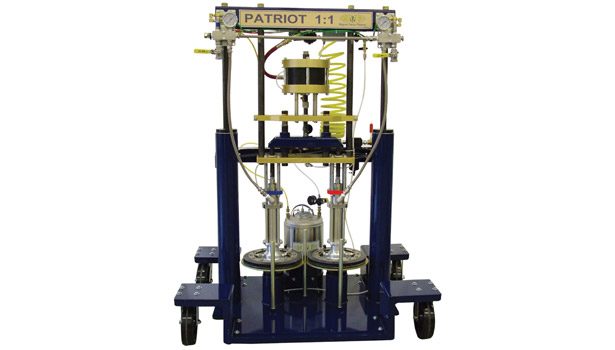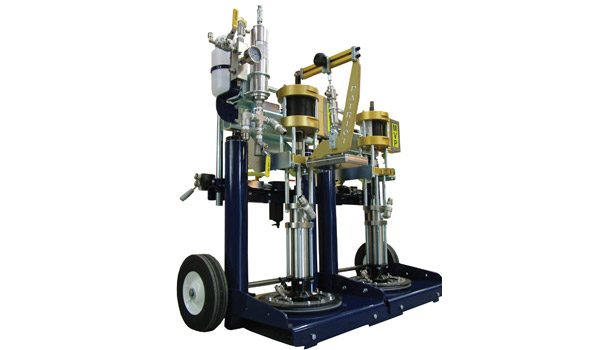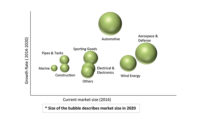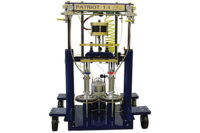Carbon Fiber: Strong Bonds, Strong Growth
Adhesives provide multiple advantages when bonding carbon fiber composite materials.




It seems like carbon fiber is popping up everywhere. There are carbon fiber cars on television shows, magazines tout the benefits of carbon fiber automotive accessories and carbon fiber airplanes have taken flight. Carbon fiber is growing rapidly, with current usage at about 99 million lbs—quite an amount for a material renowned for its light weight. Some studies project carbon fiber to grow at a rate of 11% per year for the next several years to a potential market cap of $3 billion in five years. So what does that have to do with adhesives and adhesive dispensing equipment?
“It stands to reason that increasing the size of the composites market will translate into growth for adhesive bonding,” says Jesse Smith, manager of Industrial Partnerships and Economic Development Science and Technology Partnerships at Oak Ridge National Laboratory (ORNL). “We have active projects at ORNL looking to increase the strengths of adhesively bonded composites. Composites are already penetrating the automotive market; they have embraced adhesive bonding of even metal parts. That which used to be welded is now often bonded because it is much stronger.”
Carbon Fiber Overview
Carbon fiber is stronger than most materials, and far better suited for transportation-related manufacturing than most people think. A number of industries are now manufacturing in metals and plastics that will soon transition to carbon fiber. For example, the aerospace industry reportedly intends to incorporate carbon fiber in both the commercial and government sectors. Also—and perhaps most significant—the automotive industry is making huge strides in bringing carbon fiber into many of its vehicles.
Carbon fiber is certain to be produced in increasingly larger quantities. The lighter weight and superior strength characteristics will allow its use in many vehicle applications. For example, Lexus has already successfully built a carbon fiber chassis and body shell, as well as many of the parts on its LFA model; the process was documented on the National Geographic show “How it’s Made.” Aftermarket automotive is committed to carbon fiber; carbon fiber kits are popping up everywhere.
One drawback for carbon fiber is that current technology dictates the need for carbon fiber sheets to be pre-impregnated with resin and then heated or baked to cure into a finished product. This process requires immense energy consumption. The ovens themselves are very expensive, and the pre-impregnated resin/carbon fiber sheets need to be stored in massive refrigerators to maintain the integrity of the resin saturation. The benefit of pre-impregnated carbon fiber is fast cycle times.
Closed-mold injection processes, such as closed cavity bag molding (CCBM) and light resin transfer molding (LRTM), are another option. State-of-the-art injection equipment is resulting in faster cycle times. In addition, neither ovens nor refrigerators are needed for CCBM or LRTM technologies. With closed-mold injection technology, companies like BMW will have options for building carbon fiber parts that don’t require massive amounts of energy to both cool and then heat pre-impregnated carbon fiber sheets. Along with BMW, Volkswagen and Chevrolet are both reportedly introducing more carbon fiber into their vehicles.
Why Adhesives?
While carbon fiber alone has the components within its molecular structure to be strong, carbon fiber shows its true potential when used as a substrate in composite materials. When used as a component in a composite matrix, the strength of carbon fiber, with most tolerances, can be far greater than steel. The question then becomes: How can these composite parts be joined to make a whole? Most composite structures made with carbon fiber must be chemically bonded through the use of an adhesive. There are three reasons for this:
1. In order to mechanically fasten carbon fiber, holes need to be drilled into the part. This drilling can cause immense friction and heat, however, which can damage the area around the hole. In addition, the drilling pushes the layers of fabric apart, which causes critical delamination and decreases structural integrity.
2. Many metals used in nuts, bolts and screws can have a corrosive reaction to the epoxy or resin used in carbon fiber parts, which then drastically reduces the joint strength.
3. A chemical reaction at a molecular level occurs when an adhesive bonds a part; since a composite part or structure is a chemical reaction or two of more materials coming together, using adhesives provides a stronger bond than mechanical fasteners can. This chemical bond essentially creates a single piece instead of two individual pieces joined together—a far greater way to bond or join the materials.
Carbon fiber is best suited for chemical bonding, and it lends itself to using adhesives for joining very easily. D.L Erdman and J.M. Starbuck of ORNL completed a study on this, and found: “Adhesive joining is recognized as a potential enabling technology for a variety of material systems being considered in automotive structures where traditional fastening methods would be inappropriate. Well-known examples include fiber-reinforced composites and polymers.”1
Carbon-fiber-reinforced plastic (CFRP) assemblies require innovative methods to join them with metallic or other polymeric materials. The bonding method and selection of the adhesive is especially important to guarantee the structure’s durability and long service life. In addition to preserving the integrity of the CFRP, which mechanical fastening does not, adhesive bonding offers opportunities to reduce weight and improve energy efficiency.
For example, specially formulated SCIGRIP adhesives have been used in many applications spanning a variety of industries, including sports and leisure, automotive, and civil engineering. The adhesives have been used in sports equipment (hockey sticks), safety equipment (motorcycle helmets), automobiles (car seats/frame) and construction (bridge deck components). In these applications, adhesives have provided a bond that does not interfere with the aesthetics of the items. Adhesives are also able to join dissimilar materials, and those with good chemical resistance can also help ensure the durability of CFRP assemblies in harsh conditions.
With carbon fiber’s entry into large-scale production and bonding, the need for accurately and dependably dispensing adhesives will also rise. Dependable machines are available for pumping most adhesives at ratios from 1:1 to 100:1. Dispensing machines for full-line production can be designed for use in many composite operations and other applications, such as bus manufacturers that need to bond metal on metal.
Optimized Solutions
Whether produced through pre-impregnated technology or a version of injection molding, carbon fiber products need to be joined into a finished product. That joining process is best accomplished through adhesives, which are capable of optimizing structural integrity while avoiding the need for drilling and the resulting potential for micro-fracturing and delamination. Adhesives also alleviate the need to introduce heavy bolts or nuts, which can react with the epoxies or resins that are used in the lamination process of carbon fiber. By eliminating these problems and providing beautiful cosmetic finishes, adhesives are a no-brainer for joining carbon fiber pieces.
For more information, contact the author at (865) 719-1981 or phedgerjr@mvpind.com. SCIGRIP’s website is located at www.scigrip.com.
Reference
1. Erdman, D.L.; Starbuck, J.M., “Fatigue Crack Growth in Adhesive Joints,” Oak Ridge National Laboratory, accessed April 24, 2014, http://web.ornl.gov/~webworks/cpr/pres/107198_.pdf.
Looking for a reprint of this article?
From high-res PDFs to custom plaques, order your copy today!





